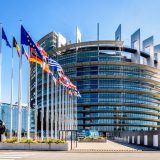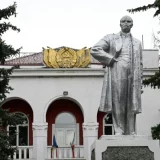The outbreak of war in Ukraine by the Russian offensive on 24 February 2022 brought war back to a territory that had not seen it for almost 80 years. Nevertheless, one of the direct consequences of this war was the energy crisis, which had already begun at the end of 2021 and which was exacerbated in this unstable geopolitical context. Aware of its dependence on certain Russian hydrocarbons – such as gas and oil – the European Union has sought to alleviate this situation through various European energy policies. Nevertheless, this situation facing the EU does not seem to be unprecedented, since the annexation of Crimea in 2013-2014 had already raised some concerns about the reliability of the Russian partner. Even earlier, the gas crises that hit Ukraine in 2006 – and which prevented it from supplying the EU with energy resources from Russia – led the European Union to find alternatives to alleviate this problem. It seems that this energy problem is not new and has its roots in older considerations. So how has European energy policy been shaped since the end of the 2000s? To what extent did the European Union anticipate this issue or not? If there was talk of energy co-dependence or interdependence between the European Union and Russia, can the same be said today? Has a European energy dependency developed and, if so, what are its characteristics? How has the EU sought to initiate or avoid this?
First, it appears that the post-Cold War context led the European Union and Russia to ensure a cordial relationship to avoid the atrocities of a twentieth century that was about to end. This period saw the collapse of the Soviet bloc in 1991, the liberalisation of the European energy market, the gradual reconstruction of the satellite countries of the former USSR, and the gradual consolidation of the European Union, leading to the signing of energy contracts between the EU and Russia in the early 2000s. The issue of energy dependence was therefore not an urgent one for the EU. In this context, Russia had everything to gain by seeking to rebuild itself by developing strategic partnerships, starting with its immediate environment. Similarly, the EU saw the Union’s needs as growing – as the EU itself expanded with the wave of integration of the Central and Eastern European countries in 2004 – and the Russian partner, by virtue of its geographical proximity, could be an essential ally. However, it is precisely from the beginning of the 2000s that the question of energy dependence began to be raised.
If this is quickly stifled, the fact remains that EUROSTAT figures show that this co-dependence is gradually becoming dependence, as the Institute’s figures show that European energy dependence stood at 47.8[1]% in 2000 and 54.1[2]% in 2010. Nevertheless, the first part of the 2010s is characterised by the European desire to develop certain strategic aspects of its energy policy, namely, to ensure safe, sustainable and efficient energy efficiency and to seek to develop renewable energy on its territory. Thus, for almost 20 years – from the 1990s to the 2010s – the EU was almost indifferent to the potential risks of dependence that could arise in the long term. Moreover, the Franco-German couple, characteristic of European construction, was an additional element in this gradual dependence in that the years 2000 and 2010 led Germany to develop their energy partnership with Russia, leading to the construction of a first gas pipeline, Nord Stream 1, and then a second one which, however, is still not in operation, Nord Stream 2. What was supposed to allow for a better energy supply to the EU has gradually turned into a form of dependency for which a large part of the European bloc – mainly Poland and the Baltic States – had warned about the longer-term risks.
This dependence was exacerbated by the fact that Moscow was the Union’s main supplier. Indeed, other European energy partners such as Norway, Algeria and parts of the Middle East were increasingly seen as minimal partners, although still essential by Brussels. The annexation of Crimea in 2014 did not lead to a consideration of energy dependency issues either, despite increasing signals from the scientific community. Furthermore, European energy policies in the early 2010s were mainly driven by the international context with the worrying conclusions of the various reports of the Intergovernmental Panel on Climate Change (IPCC). Thus, the EU’s “20-20-20” policy, aimed at reducing greenhouse gas (GHG) emissions by 20%, increasing the share of renewable energies in the European energy mix to 20% and improving energy efficiency by 20%, was put in place at that time. Overall, the EU managed to meet or exceed this target, particularly in terms of reducing GHG emissions, which were cut by 33%. This period was also characterised by a focus on improving the security of energy supply, setting a binding target of at least 27% renewable energy in its energy consumption.
However, although these European energy policies, gradually inserted and enabled by a better understanding of the European energy market, the fact remains that the EU has not managed to achieve all of these objectives or even to anticipate the energy interdependence that was increasingly turning into energy dependence. One of the explanatory limitations is rooted in legal considerations.
Indeed, energy competence is a so-called ‘shared competence’, i.e., one that is shared between the European Union and the Member States, which does not always allow for consensus, since national governments have room for manoeuvre. Moreover, the specificities and diversities of the energy mixes within the EU limit the possibilities of consensus and coherence to achieve a unified European energy policy. While some Central and Eastern European countries, such as Poland, Hungary, and Slovakia, continue to use coal and still have too high a share of oil in their energy mix, Sweden, Denmark, and the Netherlands make greater use of renewable energies.
However, these disparities can also be explained by geographical inequalities, as some states have energy resources, such as France with its nuclear power plant, while Poland, due to its geography and previous public policies, does not have this advantage. The inequalities in the energy mix between national governments also explain why energy dependence was not the main concern of the Union at the time, leading to the revelation of this dependence as a real European problem.
Moreover, the European Union is now being criticised for having pursued a very liberal policy on energy issues, thus sidelining the social question. This is now one of the issues at stake in the energy crisis, as evidenced by the exacerbated rise in energy prices since last February, even though this rise had already begun in September 2021 due to the post-Covid 19 economic revival.
Thus, the issue of energy dependency as such has not been the subject of a concrete and well-founded public policy at European level. The above-mentioned limitations may constitute justifications and elements of understanding for this ambitious European energy policy but prevented by its own internal limitations.
Nevertheless, the end of the 2010s marks a turning point in European energy policy, especially in 2019 when the new presidency of the European Commission, under the aegis of Ursula von der Leyen, asserts that it wants to make the European Union the first climate neutral territory by 2050. The European Green Deal is the guiding principle of its energy policy at European level. If this policy refers more to the climate aspect than to energy, it at least makes it possible to grasp and study the resulting legislation, such as the ‘Fit-for-55‘ plan, which has made it possible to underline the new European spirit in the energy field.
However, it is worth highlighting the apparent paradox in the framework of this project, which claims to be inclusive and sensitive to all the EU’s energy challenges, even though the project omits the problem of energy dependence on Russia, which stands at almost 60.6[3]% in 2019.
In fact, it was not until the Russian offensive in Ukraine on 24 February that a real turning point and a European awareness of the risks of energy dependence emerged. It is, therefore, in the context of this war that the EU is questioning the reliability of its major energy supplier. Moreover, European public opinion is also demanding a change of position and attitude, thus constituting an additional element of pressure on Brussels. The growing energy crisis and threats of energy cuts from Moscow have accelerated decision-making processes at EU level, resulting in a range of legislative measures. In May this year, Ursula von der Leyen presented the RePowerEU plan, which aims to break the EU’s energy dependence on Moscow. This plan reconfigures the European position and strategy, emphasising the need to diversify energy supplies and to deploy renewable energies on a larger scale in Europe.
However, despite the minimal distance we must go, some initial analyses can be made. Indeed, the EU is moving closer to politically unstable or dubious regimes – if not contrary to European values – such as Iran or Venezuela, which raises questions about Europe’s credibility in reconciling its principles and its urgencies.
Furthermore, the signing of long-term liquefied natural gas (LNG) contracts with the United States also raises questions about the long-term effects of this new partnership, leading us to wonder whether we are not witnessing a transfer of this energy dependence from Russia to the United States.
Finally, the nuclear issue has resurfaced on the European scene and is subject to debate, given the divergent positions on this subject. Indeed, France is the leading European country with the largest nuclear fleet, unlike Germany which, in the wake of the Fukushima nuclear disaster, has decreed its exit from civil nuclear power with the closure of its last power plants scheduled for the end of 2022.
In short, it appears that what could be called a European energy interdependence has gradually turned into a dependence. Indeed, the post-Cold War historical-political context no longer coincides with that of the 2020s. Moreover, the enlargement of the European Union and the energy choices made by national governments have led to disparities within the European area, resulting in a slowdown, if not sometimes confusion, as to European objectives. Although certain issues relating to energy efficiency were a priority for Brussels in the 2010s, the fact that dependence issues were not addressed explains the delicate and urgent situation facing the European Union today. Finally, it appears that the European desire is to become completely energy independent, but it seems essential to stress that this desire should not and could not be transformed into a tangible reality in the sense that the Union cannot be self-sufficient, and that the establishment of energy partnerships is essential. Rather than striving for independence, it is more a question of diversifying its supplies, even if it is known that the current situation is so unfavorable for the European Union that it is not able to really negotiate all the terms and conditions of the contracts it is led to sign. It is now a question of the Union seeking to make up for its own shortcomings by pursuing a single policy, to speak with one voice and to appear as a major player in international negotiations. Indeed, the ability of the European Union to overcome this crisis will also be indicative of its credibility on the international scene and the perception of other actors on the international political scene.
[1] Eurostat, “Évolution de la dépendance énergétique de l’UE (2000-2010)”, 23 Septembre 2013
[2] Ibidem
[3] GAILLARD Barthélémy, “La dépendance énergétique dans l’Union européenne”, Toute l’Europe, 14 avril 2021






